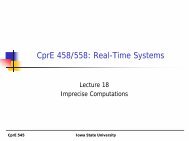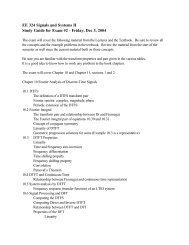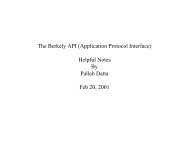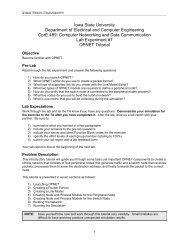CprE 458/558: Real-Time Systems
CprE 458/558: Real-Time Systems
CprE 458/558: Real-Time Systems
You also want an ePaper? Increase the reach of your titles
YUMPU automatically turns print PDFs into web optimized ePapers that Google loves.
<strong>CprE</strong> <strong>458</strong>/<strong>558</strong>: <strong>Real</strong>-<strong>Time</strong> <strong>Systems</strong><br />
Fault-Tolerant Scheduling<br />
Techniques<br />
<strong>CprE</strong> <strong>458</strong>/<strong>558</strong>: <strong>Real</strong>-<strong>Time</strong> <strong>Systems</strong> (G. Manimaran) 1
Scheduling RT Tasks with FT Requirement<br />
PB-based Fault-Tolerance<br />
• Space exclusion – primary and backup scheduled on<br />
two different processors.<br />
• <strong>Time</strong> exclusion – primary and backup should not<br />
overlap in execution.<br />
• Variants of PB-based Scheduling<br />
– PB-Exclusive – Both time and space exclusion<br />
– PB-Concurrent – Space exclusion, but concurrent execution<br />
– PB-Overlap – Space exclusion, but overlap in execution<br />
<strong>CprE</strong> <strong>458</strong>/<strong>558</strong>: <strong>Real</strong>-<strong>Time</strong> <strong>Systems</strong> (G. Manimaran) 2
Variants of PB-scheduling: Example<br />
PB-OVERLAP<br />
Processor<br />
#0<br />
P1<br />
P3<br />
Processor<br />
#1<br />
B1<br />
Processor<br />
#2<br />
P2<br />
PB-CONCURRENT<br />
B3<br />
Processor<br />
#3<br />
B2<br />
PB-EXCLUSIVE<br />
<strong>CprE</strong> <strong>458</strong>/<strong>558</strong>: <strong>Real</strong>-<strong>Time</strong> <strong>Systems</strong> (G. Manimaran) 3
Scheduling RT Tasks with FT Req. (contd.)<br />
• Each of the above three schemes has merits under<br />
certain workload and fault scenarios.<br />
– PB-Concurrent: at high fault rates, tight deadlines<br />
– PB-exclusive: at low fault rates, relaxed deadlines, high<br />
resource needs<br />
• Generalized scheme<br />
– That adapts (estimating) the “primary-backup overlap interval”<br />
based on task parameters (e.g., deadline) and fault rate has<br />
the potential to offer the best schedulability under all<br />
scenarios.<br />
TMR/NMR based FT: Space Exclusion only<br />
<strong>CprE</strong> <strong>458</strong>/<strong>558</strong>: <strong>Real</strong>-<strong>Time</strong> <strong>Systems</strong> (G. Manimaran) 4
Schedulability-Reliability Tradeoff<br />
• Too much redundancy increases reliability, but it could<br />
potentially decrease the schedulability.<br />
• Too little redundancy decreases reliability, but<br />
increases schedulability<br />
• Also, designing and managing redundancy incurs<br />
additional cost, time, space, and power consumption<br />
• Therefore, appropriate use of redundancy is important<br />
<strong>CprE</strong> <strong>458</strong>/<strong>558</strong>: <strong>Real</strong>-<strong>Time</strong> <strong>Systems</strong> (G. Manimaran) 5
Schedulability Enhancement Techniques in PBbased<br />
FT scheduling<br />
• Backup overloading<br />
– Two backups can be scheduled in a overlapping manner if<br />
their primaries achieve space exclusion.<br />
– Assumes, at most only one fault at a given time, i.e., before<br />
the second fault, the first fault is recovered.<br />
• Flexible overloading (static-grouping)<br />
– Partition the processors into groups<br />
– Schedule the primary and its backup in the same group<br />
• If primary is scheduled in group 1, its backup must also be<br />
scheduled in the group exploiting the backup overloading<br />
• Distance Concept<br />
– Relative position of primary and its backup in the task queue.<br />
– This has impact on the schedulability on branch-bound algos<br />
like the Spring scheduling.<br />
<strong>CprE</strong> <strong>458</strong>/<strong>558</strong>: <strong>Real</strong>-<strong>Time</strong> <strong>Systems</strong> (G. Manimaran) 6
Backup overloading: example<br />
Processor<br />
#0<br />
P1<br />
Space<br />
exclusive<br />
primaries<br />
P3<br />
P4<br />
Processor<br />
#1<br />
P2<br />
Backups<br />
scheduled in<br />
overlapping<br />
manner on the<br />
same processor<br />
P4<br />
B3<br />
Processor<br />
#2<br />
B1<br />
B2<br />
<strong>CprE</strong> <strong>458</strong>/<strong>558</strong>: <strong>Real</strong>-<strong>Time</strong> <strong>Systems</strong> (G. Manimaran) 7
Flexible overloading- details<br />
• In flexible overloading, all “m” processors are<br />
partitioned into different groups<br />
• Rules<br />
– Every processor is a member of exactly one group<br />
– For backup overloading to take place in a group, it<br />
must have at least three processors<br />
– The size of each group is the same (except for one<br />
group, when (m/gsize) is not an integer)<br />
– Backup overloading can take place only among the<br />
processors within a group<br />
<strong>CprE</strong> <strong>458</strong>/<strong>558</strong>: <strong>Real</strong>-<strong>Time</strong> <strong>Systems</strong> (G. Manimaran) 8
Flexible overloading: example<br />
Processor<br />
#0<br />
Processor<br />
#1<br />
Processor<br />
#2<br />
P1<br />
P2<br />
B1<br />
B2<br />
Backup<br />
overloading<br />
within the<br />
group<br />
Processor<br />
#3<br />
Processor<br />
#4<br />
Processor<br />
#5<br />
P4<br />
P3<br />
B4<br />
B3<br />
Backup<br />
overloading<br />
within the<br />
group<br />
<strong>CprE</strong> <strong>458</strong>/<strong>558</strong>: <strong>Real</strong>-<strong>Time</strong> <strong>Systems</strong> (G. Manimaran) 9
Distance concept: details<br />
• Distance concept – the relative position of a primary<br />
task and its backup task in the task queue<br />
• For a given set of “N” active tasks and a given<br />
distance of “d”<br />
• For all tasks, T i<br />
– Distance (Pr i , Bk i ) is equal to<br />
• d for the (N – (N mod d)) tasks<br />
• N mod d for the (N mod d) tasks<br />
<strong>CprE</strong> <strong>458</strong>/<strong>558</strong>: <strong>Real</strong>-<strong>Time</strong> <strong>Systems</strong> (G. Manimaran) 10
Distance concept: example<br />
•N= 4<br />
•d = 3<br />
P1 P2 P3 B1 B2 B3 P4 B4<br />
•N= 4<br />
•d = 2<br />
The distance concept<br />
introduces a tradeoff<br />
between performance<br />
and fault tolerance in the<br />
myopic algorithm.<br />
Distance should be<br />
appropriately chosen.<br />
The distance should be<br />
neither too low nor too<br />
high<br />
P1 P2 B1 B2 P3 P4 B3 B4<br />
<strong>CprE</strong> <strong>458</strong>/<strong>558</strong>: <strong>Real</strong>-<strong>Time</strong> <strong>Systems</strong> (G. Manimaran) 11
Distance – some implications<br />
– Backup postponement<br />
• If backup task is too closer (in queue position)<br />
relative to its primary, holes get created in the<br />
schedule, resulting in lower schedulability.<br />
– Forced backtrack<br />
• If backup task is too far (in queue position)<br />
relative to its primary, missing the deadlines of<br />
backup could happen which would result in<br />
backtrack.<br />
[Read pages 108-115 in the book]<br />
<strong>CprE</strong> <strong>458</strong>/<strong>558</strong>: <strong>Real</strong>-<strong>Time</strong> <strong>Systems</strong> (G. Manimaran) 12
Performability measures<br />
• Which is better High schedulability or high relaibility<br />
• Overall system metric is required<br />
• Performability metrics combine schedulability and<br />
reliability into a single metric that captures the<br />
overall system goal<br />
• Goal: Determining Redundancy level to maximize<br />
the performance index (PI)<br />
[Read pages 122-123 in the book]<br />
<strong>CprE</strong> <strong>458</strong>/<strong>558</strong>: <strong>Real</strong>-<strong>Time</strong> <strong>Systems</strong> (G. Manimaran) 13
Determining Redundancy Levels (contd.)<br />
• Performance index (PI) is a measure that captures both performance<br />
and reliability requirements<br />
• PI is defined as follows: For a task Ti,<br />
PI i = V i * R i – P i * F i<br />
if T i is guaranteed<br />
-Q i if T i is not guaranteed<br />
Where,<br />
Vi = reward if Ti completes successfully<br />
Ri = reliability of a task (1 – Fi)<br />
Fi = Failure probability<br />
Pi = penalty if Ti fails after being guaranteed<br />
Qi = if Ti has not been guaranteed<br />
The total PI = ∑ i=1n PI i<br />
<strong>CprE</strong> <strong>458</strong>/<strong>558</strong>: <strong>Real</strong>-<strong>Time</strong> <strong>Systems</strong> (G. Manimaran) 14
Determining Redundancy Levels<br />
• Goal:<br />
Given the relevant parameters for each of the “n”<br />
tasks to be scheduled on a set of “m” processors,<br />
the goal is to determine the appropriate redundancy<br />
levels for each task in order to maximize the total<br />
PI.<br />
• Let Ri be the reliability of the task with one version, the<br />
reliability of the task with “n” versions is given by<br />
1 – (1 - Ri) n<br />
<strong>CprE</strong> <strong>458</strong>/<strong>558</strong>: <strong>Real</strong>-<strong>Time</strong> <strong>Systems</strong> (G. Manimaran) 15
Determining Redundancy Levels: example<br />
Given task-set<br />
Task (Ti) Task attributes Penalty/reward<br />
T1, T2, T3, T4 R i = 0, C i = 10,<br />
Calculations<br />
D i = 10<br />
U PI = ∑ PI i<br />
1 4 ( 10 * 0.9 – 100 * 0.1) = -4<br />
2 2(10 * 0.99 – 100 * 0.01) - 2 = 16<br />
3 1(10 * 0.999 – 100 * 0.001) – 3 = 7<br />
V i = 10, PI is Pmaximum<br />
i = 100,<br />
Q i = 1<br />
4 1(10 *0.9999 – 100 * 0.0001) – 3 = 7<br />
U: redundancy level<br />
at u = 2.<br />
Therefore, a<br />
redundancy<br />
level of 2 is<br />
optimal<br />
<strong>CprE</strong> <strong>458</strong>/<strong>558</strong>: <strong>Real</strong>-<strong>Time</strong> <strong>Systems</strong> (G. Manimaran) 16
Fault-tolerance -- conclusions<br />
• Dependability concepts<br />
• Fault-tolerant design techniques<br />
• Fault-tolerant scheduling<br />
– Primary-backup scheduling<br />
– Schedulability enhancement techniques<br />
– Redundancy level determination<br />
• Imprecise computations<br />
– Imprecise computational model<br />
– (m,k)-firm model<br />
<strong>CprE</strong> <strong>458</strong>/<strong>558</strong>: <strong>Real</strong>-<strong>Time</strong> <strong>Systems</strong> (G. Manimaran) 17
















